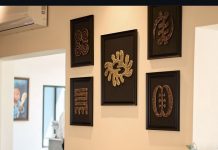“In a badly designed book, the letters mill and stand like starving horses in a field. In a book designed by rote, they sit like stale bread and mutton on the page. In a well-made book, where designer, compositor and printer have all done their jobs, no matter how many thousands of lines and pages, the letters are alive. They dance in their seats. Sometimes they rise and dance in the margins and aisles.”
― Robert Bringhurst
Have you read or heard the scripture that God looks in the heart and man looks at outward appearance? How true this is. People do not carry x-ray devices to measure the credibility of your heart. Before you make any impression, an evaluation has been made about you based on your looks.

For us humans, our attire speaks volumes even before we open our mouths. First impressions are formed in an instant, and appearance can heavily influence someone’s initial judgement and/or opinion of a person’s competence and capability. In as much as this can be deceptive, the truth is that it is the reality on how humans relate. When the prophet Samuel was sent by God to anoint one of Jesse’s children to be king, appearance, packaging and looks were the first influencers for the prophet.
As an author, you need to be mindful that your target audience are not angels but men and women just like the prophet; we will judge your book by its cover. You may have the most compelling and interesting contents in your book, but if your cover design is not as compelling and attractive you are likely to read your book alone.
Especially for a new author, the angels may even doubt your credibility. Angels know and like good things. Seen the scripture that talks about how the daughters of men appealed to angels?
Package your books well with a good cover and in-text design. I have a friend who says he has inner money; his counterparts need to look beyond his now. Try as he may try, he might not even appeal to angels let alone the daughters of Eve. Before people read your book, they need to see the inner beauty and inner money your publication will potentially offer them. Your book design gives readers their first impression about the book and its content. First impressions can never be overrated.
In my capacity as a career coach, I am mindful that recruiters make decision on candidates within the first few minutes, some even seconds. Imagine your whole credibility, some one sees you in a day and says you are good or not for the job because of how you appear?
Your book must be attractive and interesting. When people walk into shops to buy books, the first thing they look at is the front cover, followed by the back cover; then they flip a few pages before deciding to purchase or not. If your cover design does not intrigue people, then you may not sell as much unless you are well-known already.
As you rightly assumed, in this publication we discuss how to make a book design and layout that attracts buyers.
- Cover picture: The cover picture of your book is the picture you place on the front cover. It can be a picture you take at Flash Photos or Photo Store. At least, not from the roadside red-background passport picture photographers. Those ones have their purpose. Your cover photo must be chosen carefully because it gives further meaning to your title. In most instances, the cover photo on a book may not be that of the author.
Either way, the picture is the visual representation of the title and content of your book; hence, make it appropriate so people easily understand the concept of your book. For instance, in ‘The Art of Shepherding’ renowned author Bishop Dag Heward Mills uses a picture of a sheep to explain his concept of shepherding. The idea here is to use an image in a creative way that captures the concept of your book.
However, for the purpose of marketing an author may use their own picture on the cover. This is especially for people with strong personalities or popular people like politicians, musicians and TV personalities. These people are able to sell their books with their faces because they are well known. Michelle Obama’s ‘Becoming’ has her picture on the cover.
There are others like Nana Konadu Agyemang Rawlings’ ‘It Takes a Woman’, and Oheneyere Gifty Anti for instance has her picture on the cover of her three books: A Bit of Me, The Best of You and Fifty Nuggets @ 50.
For radio personalities, your names are more popular than your faces so it is prudent for you to enlarge and focus more on your names rather than your picture. Except in recent times when radio stations make use of social media, many people could connect with most radio personalities by name more than by face.
- Colour: Closely related to the idea of a cover picture is the choice and frequency of colours used for the cover design. My books ‘Hello Intern’, ‘Career Advantage’ and ‘Courting Greatness’ have carefully selected colours with at most 3 colours for the cover design. This is a style very commonly used by globally-celebrated leadership coach and writer, John C. Maxwell. Most John Maxwell books have 2 or 3 colours at most. The reason? Well, it may be a matter of style. But for me I appreciate the simplicity in that art as well.
- Information distribution: This relates to information on the author. There is no need to put all your information on the front cover of your book. It makes the design clumsy and many readers do not like that. The most important things on the cover apart from the picture should be your name, title of your book and sub-title if there is one. The blurb of the book and information about you should go on the back cover. There are instances when an author’s profile is too long to fit the back cover page, but do not be tempted to cramp it all in and make people strain their eyes just to see what stuff you are made of. You can have a brief profile at the back and dedicate just the last inner page of the book to a detailed one.
- Spine and binding: The book’s binding usually depends on its size. Very small books can use saddle-stitch while slightly bigger books use perfect binding. However, you need to compare and contrast the two to determine which one is more advantageous to you. For perfect binding, you get a clean-cut spine that you can put some details of your book on. For instance, your name and title of the book. Books are usually arranged according to titles on the shelves whether it’s a shop or a library, so if your book does not have a spine that contains these details then readers cannot easily identify it.
- In-text design: For readers to stay longer on your text, you need to make it appealing. In-text design here refers to the arrangement and appearance of texts, pictures, diagrams and even the use of font in your book. Do not make people strain their eyes to read your book. Ensure that your layout is user-friendly and audience appropriate. Books for adults have a completely different layout from those of kids. Children’s books usually use large and beautiful font, illustrative pictures and lots of colours. Books for adults do not necessarily need all these flamboyances – but this doesn’t also mean it should be clumsy and/or difficult to read. Use spacious and easily readable font. Where necessary, use illustrations, pictures and diagrams.
One very important thing some authors usually forget is the editing after design and layout are done. I know authors who have disposed of thousands of their books after a typo was identified on the cover or inside of the book after the print consignment was delivered.
Request sample hard copies of your book. Seeing is believing. You should use beta editors at this stage. Seek their opinion on the font, the spacing, illustrations and what have you. You may be surprised to see some errors that you missed in the soft copy.
Use a professional designer to ensure that your book has the best quality design. Also, note that not all designers can do great cover or in-text designs. A designer may be brilliant at cover design but suck at in-text design, so choose someone who can do both or hire different people for the different designs; “e dey your pocket inside” (depends on your budget). I also recommend you get feedback on your cover from prospective readers. What might capture the concept of your book may appeal differently from the readers’ perspective.
Once you sort all these out you can instruct your publishers to do the bulk print, otherwise if you do not access sample copies ahead of print you go do yawa.
>>>the writer is a corporate trainer, book publishing consultant and professional ghostwriter assisting busy executives to write and publish their books, articles, and speeches. He has served as Head of Protocol at a diplomatic mission, Corporate Affairs Officer at a French multinational agribusiness and as Events and Media Correspondent for a digital ad agency. You can contact the author via: [email protected]










